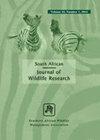Using Detection/Non-Detection Surveys and Interviews to Assess Carnivore Site Use in Kenya
引用次数: 2
Abstract
Understanding species' site use patterns is important for conservation and human—wildlife conflict mitigation where humans, livestock and large carnivores coexist. We used occupancy models and interviews to evaluate site use by medium and large carnivores within the rural Meibae Community Conservancy and agriculturally-developed Salama areas of Kenya. We conducted monthly surveys for 4 months along 32 transects covering 160 km in both study areas, and collected detection/non-detection data for nine carnivore species (>10 kg) via direct sighting, tracks and scat. We modelled carnivore site use against both anthropogenic and environmental variables while accounting for imperfect detection, and conducted interviews to determine presence of conflict carnivores. Black-backed jackal (Canis mesomelas) and spotted hyaena (Crocuta crocuta) site use was most strongly associated with higher livestock abundance. Rare or wider-ranging species were seldom (e.g. cheetah, Acinonyx jubatus) or never (e.g. African lion, Panthera leo) detected on transect surveys but were reported during interviews. We conclude that transect surveys were unreliable for evaluating presence of less common species in our study areas. While interviews were more effective, we recommend that future interviews should account for potential false-positive detections. We make suggestions for improving surveys and recommend combining methods to quantify site use by wide-ranging and cryptic carnivores.利用检测/非检测调查和访谈评估肯尼亚食肉动物栖息地的使用情况
了解物种的场地使用模式对于保护和缓解人类、牲畜和大型食肉动物共存的人类与野生动物冲突非常重要。我们使用占用模型和访谈来评估肯尼亚Meibae社区保护区和农业发达的Salama地区的中型和大型食肉动物的场地使用情况。我们在两个研究区的32条160公里的样带上进行了为期4个月的月度调查,并通过直接观察、追踪和粪便收集了9种食肉动物(>10公斤)的检测/未检测数据。我们根据人为和环境变量对食肉动物栖息地的使用进行了建模,同时考虑到检测的不完善,并进行了访谈以确定冲突食肉动物的存在。黑背豺(Canis mesomelas)和斑点鬣蜥(Crocuta Crocuta)的栖息地使用与较高的牲畜丰度密切相关。在样带调查中很少发现稀有或范围更广的物种(如猎豹、朱巴豆)或从未发现(如非洲狮、狮子豹),但在访谈中报告了这些物种。我们得出的结论是,样带调查对于评估我们研究区域中不太常见的物种的存在是不可靠的。虽然访谈更有效,但我们建议未来的访谈应考虑潜在的假阳性检测。我们提出了改进调查的建议,并建议结合各种方法来量化广泛和隐蔽的食肉动物对场地的使用。
本文章由计算机程序翻译,如有差异,请以英文原文为准。
求助全文
约1分钟内获得全文
求助全文

 求助内容:
求助内容: 应助结果提醒方式:
应助结果提醒方式:


